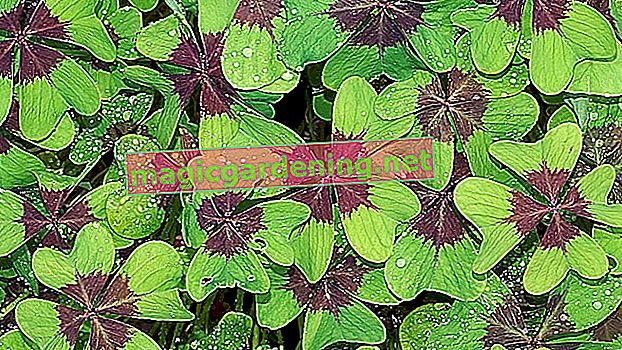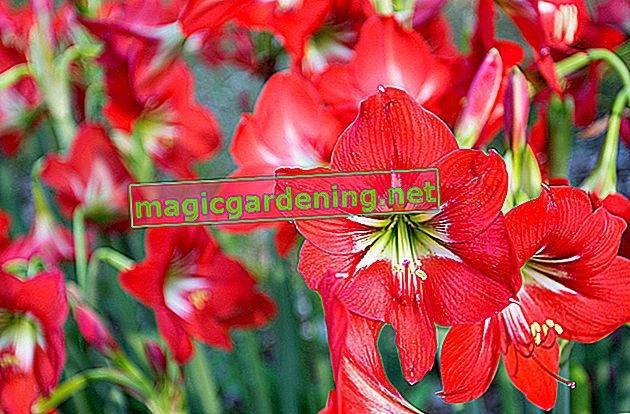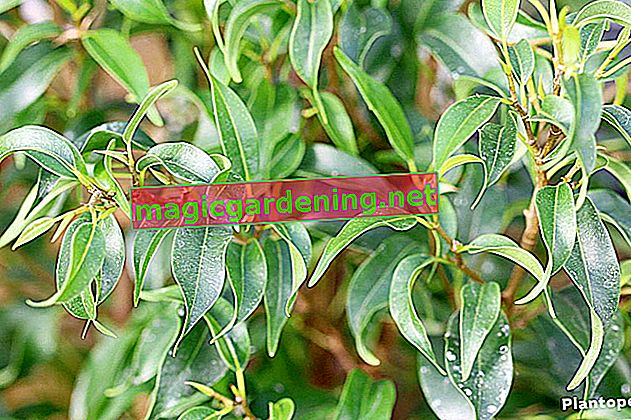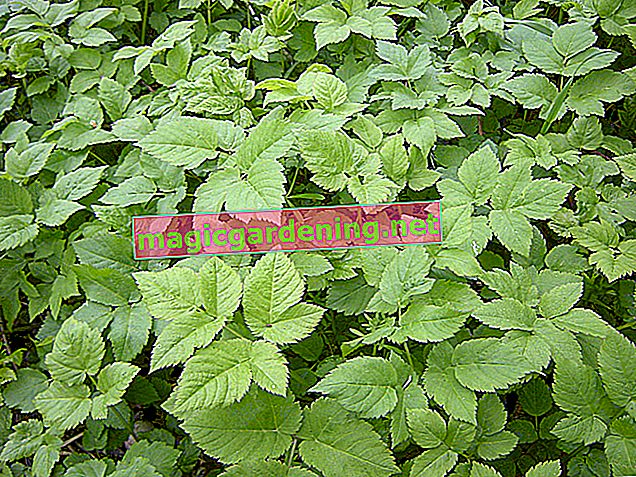
No beautiful lawn without nutrients - a plea for fertilizers
A velvety green, even lawn carpet will not thrive on its own. As part of the regular lawn cutting, a large part of the existing nutrients is consumed and transported away in the grass catcher. Although lawn grasses have a dense network of roots, the main root mass is in the upper soil layer. During the growing season, adequate compensation through targeted lawn fertilization is therefore necessary. These nutrients are mainly to be supplied:
- Nitrogen (N) for constant growth, lush green grass and strengthening of the cells
- Phosphorus (P) for healthy, strong roots and to regulate the energy balance
- Potassium (K) for promoting resistance, strengthening the metabolism and improving frost resistance
also read
- Liming the lawn properly - the 10 best tips
- Fantastically beautiful lawn - the 10 best tips for lawn care
- How to properly fertilize the medallion - the best tips and tricks
In addition, minerals and trace elements are important so that the noble grasses of the lawn are not lost to weeds and moss.
Soil analysis ensures transparency
If a lawn suffers from a lack of nutrients, this deficiency is visually recognizable by poor growth or a pale color. A professional soil analysis shows what exactly is a problem. To do this, take soil samples from the upper soil layer at 10-12 locations on the lawn. These are mixed in a bucket to send 500 grams to an appropriate laboratory.
After 3-4 weeks you will receive a dedicated result on the soil condition including a fertilizer recommendation. Carry out a soil analysis every 4-5 years, you will know the weak points in the nutrient supply. As part of lawn fertilization, you compensate for the deficiencies biologically or minerally and avoid the risk of over-fertilization.
Short-term fertilizers wake up tired lawns
In order to stimulate the growth of the lawn in spring, the use of calcium ammonium nitrate (KAS) has proven its worth. This is a fertilizer that mainly contains nitrogen (28%). At the time of lawn fertilization, calcium ammonium nitrate sets in motion a surge growth that leaves weeds and moss no chance.
- Advantages of KAS: immediate effect, while at the same time displacing moss and weeds
- Disadvantages of KAS: contains neither phosphorus nor potassium, high risk of burns from noble grasses
Lime ammonium nitrate is therefore a short-term fertilizer that cannot replace full-fledged lawn fertilization. In addition, the active ingredient is harmful to the environment due to the rapid leaching of nitrates into the groundwater.
Tips
Common weed killers only work properly when the unwanted plants have a large leaf mass. The larger the dandelion and colleagues are at the time the herbicide is applied, the more effective the control success will be. Experienced hobby gardeners therefore fertilize the weed-covered lawn with calcium ammonium nitrate in the run-up to 2 weeks in order to then deal the devastating blow to the weeds that shoot up.
Apply complete fertilizer to the lawn at most once a year
In mineral lawn fertilization, take the path of least resistance with a complete fertilizer such as blue grain. In use since 1927, this purely chemical preparation is still used today in kitchen and ornamental gardens. The fertilizer is ideally dosed according to the findings of a soil analysis. A single application in spring between March and April is sufficient for a normally stressed lawn. How to proceed:
- Spread fertilizer with the spreader on dry lawn
- Avoid an overlapping distribution
- Immediately after fertilizing, sprinkle the lawn extensively
The damaging effect on the environment results primarily from the rapid leaching of nitrate into the groundwater and drinking water within 2 weeks. The newly developed product Blaukorn Entec extends this period to 8 weeks, which is supposed to reduce the nitrate load and increase the fertilizing effect.
The best long-term fertilizers for the lawn
Those who are not satisfied with short-term lawn fertilization should turn their attention to mineral-organic fertilizers with long-term effects. These preparations combine the immediate effect with a long-lasting supply of nutrients for up to 120 days. The advantage is that the grasses don't just shoot up. Rather, they develop in width at the same time, which results in a velvety green carpet.
The following table shows some outstanding mineral-organic long-term fertilizers, which enjoy consistently good customer ratings on the market:
| Long-term lawn fertilizer | Wolf LE 100 Premium | Floranid long-term lawn fertilizer | Cuxin DCM special | Profi Green | Substral long-term lawn fertilizer |
|---|---|---|---|---|---|
| Fertilizer type | organic-mineral | organic-mineral | organic-mineral | organic-mineral | organic-mineral |
| NPK composition | 29 + 5 + 7 | 22 + 5 + 11 | 12 + 4 + 6 | 7 + 5 + 5 | 22 + 5 + 5 |
| Duration of effect | 120 days | 180 days | 100 days | 100 days | 100 days |
| dosage | 50 g / m² | 50 g / m² | 40 g / m² | 70 g / m² | 20 g / m² |
| price | 39 euros for 5 kg | 28 euros for 5 kg | 36 euros for 20 kg | 25 euros for 30 kg | 31 euros for 5 kg |
Overview of fertilizer dates - when lawn fertilization makes sense
There is no silver bullet for the ideal fertilization plan. Rather, there are various factors that dictate the rhythm of lawn fertilization with mineral-organic preparations. This includes the type of lawn, the nature of the soil, the weather and the location. The following guidelines apply as a guideline (€ 4.86 at Amazon *):
- Time for ornamental lawns with normal use: in spring (March / April) and in summer (July / August)
- Time for extremely stressed sports and play lawns: in March, May, August and October
- Time for shadow lawns: in March / April, in June / July and in September / October
When exactly lawn fertilization should be carried out, the composition of the selected fertilizer determines in particular. The exact dosage of NPK is indicated on each packaging: N for nitrogen, P for phosphorus and K for potassium.
Naturally fertilize lawns in harmony with nature - this is how it works
If you want to fertilize your lawn naturally, a fertilizer with only organic ingredients comes into focus. These are of purely vegetable or animal origin and are first broken down by microorganisms before they are available for the lawn. This not only ensures the supply of nutrients; at the same time there is long-term soil improvement.
Of course, you fertilize green spaces with compost, stable manure, plant manure, horn meal or horse manure. When you fertilize the lawn biologically, in turn, depends on the specific conditions on site. You basically do it correctly, according to the following schedule:
- In spring and summer, 30 liters of compost per square meter plus 30 grams of horn meal
- Comfrey manure containing potassium in September or October to strengthen winter hardiness
- Alternatively, apply commercially available organic fertilizers in March, May, August and October
Scarifying increases the willingness to absorb fertilizer
Regardless of whether you fertilize with mineral, mineral-organic or organic fertilizers, you can increase the effectiveness of lawn fertilization with the following care measures:
- Scarify the grass area before fertilizing the lawn in March and September
- Then apply the fertilizer with the spreader, by hand or with a pressure sprayer
- Thorough irrigation is mandatory, even if you fertilize naturally
Lawn seed and fertilizer at the same time - the efficient new plant
If lawn seeds and natural fertilization go hand in hand, you give your green business card an excellent start-up aid. The best time to plant new lawns is in September or October. The soil is still sun-warm, so that the grass roots can establish themselves well before winter.
An organic starter fertilizer can be distributed at the same time as the lawn seed, because there is no risk of burning the tender seeds. The Neudorff Azet Lawn-Start-Fertilizer, for example, has a purely biological composition so that the microorganisms in it take care of vigorous root growth.
Fertilize in autumn with a view to winter - potassium does it
In September, the lawn begins to grow for the last time before winter. In order to properly prepare it for the cold season, experienced hobby gardeners use a special fertilizer for autumn. Instead of pushing the noble grasses forward again with nitrogen, lawn fertilization emphasizing potassium is used. Biologically oriented lawn owners choose an organic NPK fertilizer with a composition of 7 + 3 + 10. How to do it right:
- Scarify the lawn lengthways once in September or October
- Spread organic autumn fertilizer with the spreader and water
- Alternatively, fertilize naturally with home-made comfrey liquid manure or pure wood ash
The special effect of potassium on winter hardiness is based on the fact that this nutrient specifically strengthens the cell walls in plant tissue. Thanks to this careful lawn fertilization, the grasses can cope with the strenuous temperature fluctuations in winter with alternating frost and thaw weather.
Tips & Tricks
Tired of annoying scarifying? Then get some help in the form of microorganisms that lawn thatch and moss like to eat. The new micro-lawn fertilizer from Cuxin contains plenty of soil organisms that transform moss and felt into valuable humus over a period of up to 100 days.








